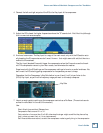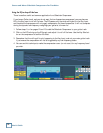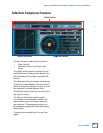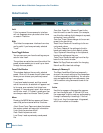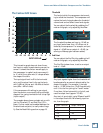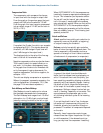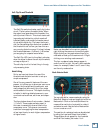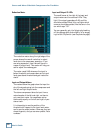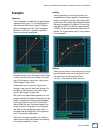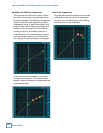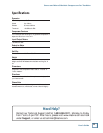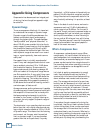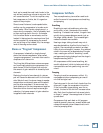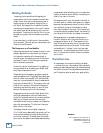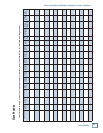
User’s Guide
26
Stereo and Mono Sidechain Compressors for Tracktion
Working the Knobs
Lowering the threshold while keeping the
compression ratio fi xed reduces the maximum
output level, since you’re compressing over a
larger portion of the dynamic range of the in-
put signal. By keeping the threshold fi xed but
increasing the compression ratio, you’ll reduce
the output level by compressing only the loud-
est signals. There are no rules for this. Let your
ears be your guide, with the meters as a sanity
check.
As an exercise, try plotting out a few combina-
tions yourself. Then set up your compressor and
listen to the differences.
The Compressor as a Tone Modifi er
Adjusting the attack and release times of a com-
pressor applied to an instrument can change
its timbre by rounding off a sharp attack or
stretching out the sustain portion of the note’s
envelope. It’s sort of like having an equalizer
with a different parameter.
A drum hit can be “stretched out” by applying
a long release time, a healthy gain boost, and
fairly high compression ratio.
Compressing low-frequency program material
requires special care. The attack and decay por-
tions of a kick drum are 60 to 80 milliseconds
long, but a low-pitched kick has a fundamental
frequency of about 40 Hz. This means that only
three of four cycles of the kick’s fundamental
frequency are heard on each hit, much of that
being in the decay portion of the envelope.
Compressing the drum with a fast attack time
and high compression ratio will make more
cycles of the attack portion of the drum audible,
making its “thump” sound much more pro-
nounced without having to boost low frequency
gain with an equalizer. Try this next time you
want a kick in the chest.
The beater attack is at a higher frequency
(1 to 3 kHz) so a moderately fast attack will let
a few cycles of beater through while working
on the low “whump.” Slowing down the attack
lets more of the beater sound pass before being
compressed, often allowing you to increase the
impact of the kick drum without increasing the
level of the track in the mix.
Compressors with very fast attack time that of-
ten work well on vocals, work poorly on a bass
because the compressor actually tries to follow
the individual cycles of the waveform rather
than the envelope of the note. This characteris-
tic can be used as a special effect, but usually it
just takes all the life out of a bassy instrument.
Some people put a hardware compressor in-
line with a signal, with the controls set for no
compression action at all. One reason is that
they like what the electronics of the input and
output amplifi ers do to the sound. This is most
noticeable with “vintage” units that use tube
electronics – a mighty expensive tube-in-a-box,
but if it’s there and it works, there’s no reason
not to use it.
The Bottom Line
A compressor can never be used by the book
– not even this one. You need to listen carefully
when you make adjustments. By understanding
the effect of each of the adjustable parameters,
you’ll be better able to reach your goal quickly.
Answers
A: Baltimore
B. The Red Sox by three runs
C. Each alternate Wednesday
D. Susie had three more dB than Julie



